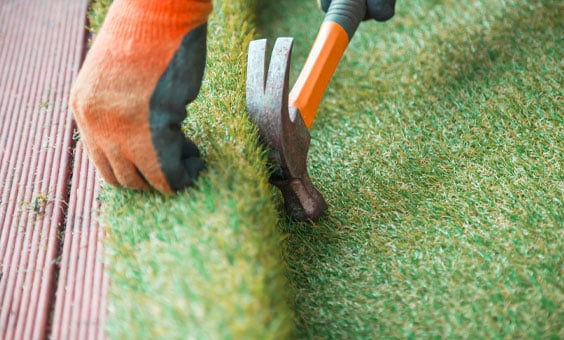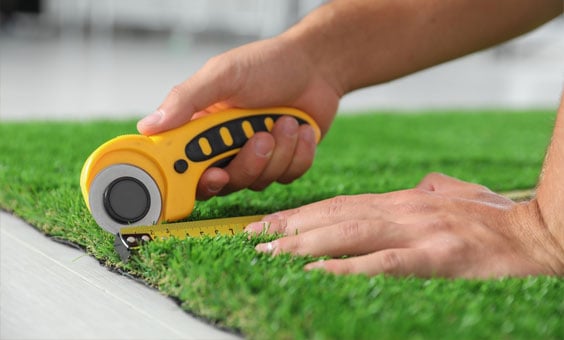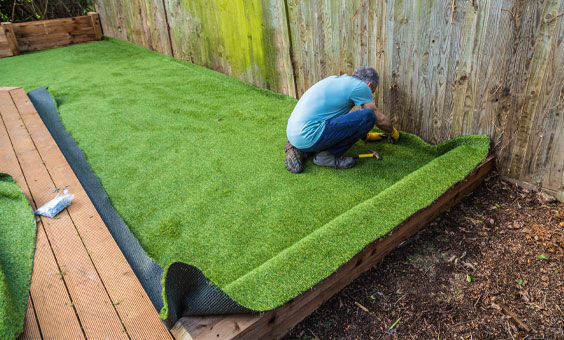How to lay artificial grass
Once you’ve decided which artificial grass will bring out the best in your garden, it’s time to lay it! We’ve pulled together a guide filled with expert hints and tips to make it as easy as possible.

Below is a brief overview of the tasks ahead to help you achieve your perfect lawn!
- Gather the tools you’ll need
- Remove any existing turf
- Prepare the base layer
- Apply a layer of sand
- Create an even surface
- Put down a layer of shock-absorbent material
- Remove the grass-free border from the artificial turf
- Align the grass
- Cut the turf to the shape you want
- Lay the grass
- Brush sand into the grass
The stages of artificial grass installation
Before getting stuck into your new renovation project, it’s important to have everything you need. This easy-to-follow guide will take you through each step on laying artificial grass in your garden, which includes:
Artificial grass installation tools
Make sure you have the right tools for the job. This will make sure you achieve the best possible finish and should make the process easier for you.
- A sharp knife and spare blades
- Knee pads and gloves
- Tape measure/straight edge
- Compaction plate or roller
- Turf cutter
- Stiff outdoor broom or motorised power brush
- Skip
- Sand spreader
- Notched trail
Preparing your base for artificial grass
Before you begin
- Check for any water ponding
- Does your garden have adequate draining?
- Remove any weeds or plants that you no longer want in your garden
- Check that access points (back doors, gates etc.) to your garden are clear
How to prepare a hard surface for artificial grass
- The surface needs to be smooth, clean and level. However, if there are any undulations in the concrete apply a thin layer of sand on top of the sub-base which will help to level and fill in any minor defects.
- Make sure you are happy with the required height of grass against the existing area, allowing for any sub-base preparation.
- Remove the natural turf using either a mechanical turf cutter or a spade.
- Remove the natural grass and subsoil to a depth of 10cm (if your ground is well compacted and free draining remove 7cm). Artificial grass should not be installed directly onto topsoil.
- Compact the surface with a roller or vibrating plate (both can be hired).
- Spray the area with a weed killer and then install weed membrane.
- If a timber surround is needed, place it at this stage whilst ensuring that it is not above the final planned grass line.
- Apply a minimum of 75mm of clean Type 1 or limestone 20mm grade size aggregate onto the surface and compact the stone with a roller or vibrating plate.
- After compacting the aggregate, use a layer of fine stone – 6–14mm grade size or builders’ type sand (sometimes called sharp sand or grit sand) to a depth of 20–40mm. Compact this to the required level, topping up if needed to achieve the desired level.
How to lay artificial grass
Solid base (Concrete area)
- Roll out your grass onto the levelled area allowing 5cm of extra grass on all sides. This will give you enough material to make sure a perfect edge. Leaving your grass to settle for 2–3 hours will help remove any creases.
- Trim your grass carefully using a sharp knife to give it a smooth and neat finish. We recommend that you turn the grass over and run your knife neatly next to the stitch lines avoiding cutting into the stitches. You can use carpet tacks to secure the grass to a wooden surface or decking or an adhesive suitable for outdoor use on a concrete surface.
- For large areas you may have to join two pieces of grass. For this you need to buy joining tape and adhesive (see point 3 under Sand and Stone Base).
Sand and stone base
- Roll out the grass onto your level, compacted base then allow the grass to settle for 2–3 hours or preferably overnight. When deciding which direction to lay your grass bear in mind that artificial grass looks at its best when you’re looking into the pile of the grass.
- Trim your grass carefully using a sharp knife to give it a smooth and neat finish. We recommend turning the grass over and running your knife neatly next to the stitch lines avoiding cutting into the stitches.
- For large areas you may have to join two pieces of grass. For this you will need to buy a joining tape with a suitable adhesive (ensuring that both are suitable for outdoor use).
- You can either use a wooden batten to secure your grass or use landscaping nails placed every 10–20cm.
- Remove all of the surplus pieces of grass and brush with a broom.
How to join artificial grass
You may have to join two pieces of grass together for large areas. For this you will need to buy a joining tape with a suitable adhesive (ensuring that both are suitable for outdoor use).
- Unroll your artificial grass into position.
- Cut close to the bead on the first piece of grass, ensuring there are no spaces. SEE PICTURE A
- On the second piece, cut leaving a space for the beading.
- Create a ‘dry’ join by positioning the two pieces together. SEE PICTURE B
- Unroll the joining tape and fold back the joining edges by about 30cm. Make sure the shiny side of the tape is face down. SEE PICTURE C
- Spread glue onto the joining tape. TOP TIP: Use a scraper to spread the adhesive. SEE PICTURE D
- Work your way down the seam carefully, joining the two pieces together. Make sure tufts aren’t damaged or buried. SEE PICTURE E
- Once it has been applied, lightly brush over the seam to pressurise the adhesive.
In the days after fitting
- Regular brushing of your grass with a broom or plastic leaf rake will help to keep the fibres straight and even.
- Leaves and other dirt can be removed with a broom, leaf rake or leaf blower.
- Spillages can be washed away with water. Dog or cat faeces can be left to harden and then be removed. A diluted disinfectant can be used to wash away any residue.
- Avoid sharp objects and spread the load of garden furniture, trampolines or outdoor play equipment to minimise indentations.
- Make sure that barbeques or other hot objects do not come into contact with your grass.









